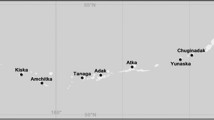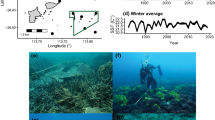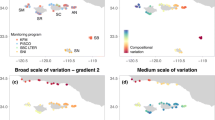Abstract
Rocky reefs and kelp forests form conspicuous habitats that promote species diversity and support livelihoods in coastal communities. However, taxonomic approaches often disregard biological identity and differences between species. In this study, we explore the relationship between functional diversity of fish communities and habitat complexity in temperate reefs and test if greater habitat complexity, such as rugosity or kelp three-dimensional structure, would result in higher functional diversity. We conducted fish surveys using SCUBA in four kelp forest sites and rocky reef sites. Although the rocky reef and kelp forest sites showed differences in habitat complexity, no significant differences in fish taxonomic or functional diversity were found between the two habitat types. However, we did find differences at smaller spatial scales for the kelp forest sites, where number of stipes, stipe bundle diameter, and kelp density influenced functional richness, but not species richness, highlighting the importance of functional approaches in certain ecosystems. The differences found among kelp forest sites may be linked with small-scale spatiotemporal oceanographic drivers of productivity such as upwelling exposure or nutrient availability. We recommend considering small-scale spatial drivers when aiming to understand how habitat characteristics link with functional diversity.



Similar content being viewed by others
Data availability
The datasets generated during and/or analysed during the current study are available in the GitHub repository “FunctionalDiversity_Baja2022”, https://github.com/mpaulasg/FunctionalDiversity_Baja2022.
References
Almany, G. R., 2004. Does increased habitat complexity reduce predation and competition in coral reef fish assemblages? Oikos 106: 275–284. https://doi.org/10.1111/j.0030-1299.2004.13193.x.
Angel, A. & F. P. Ojeda, 2001. Structure and trophic organization of subtidal fish assemblages on the northern chilean coast: the effect of habitat complexity. Marine Ecology Progress Series 217: 81–91. https://doi.org/10.3354/meps217081.
Arafeh-Dalmau, N., G. Montaño-Moctezuma, J. A. Martinez, R. Beas-Luna, D. S. Schoeman & G. Torres-Moye, 2019. Extreme marine heatwaves alter kelp forest community near its equatorward distribution limit. Frontiers in Marine Science 6: 1–18. https://doi.org/10.3389/fmars.2019.00499.
Brooks, M. E., K. Kristensen, K. J. van Benthem, A. Magnusson, C. W. Berg, A. Nielsen, H. J. Skaug, M. Mächler & B. M. Bolker, 2017. GlmmTMB balances speed and flexibility among packages for zero-inflated generalized linear mixed modeling. The R Journal 9: 378–400. https://doi.org/10.32614/rj-2017-066.
Cáceres, I., E. C. Ibarra-García, M. Ortiz, M. Ayón-Parente & F. A. Rodríguez-Zaragoza, 2020. Effect of fisheries and benthic habitat on the ecological and functional diversity of fish at the Cayos Cochinos Coral Reefs (Honduras). Marine Biodiversity. https://doi.org/10.1007/s12526-019-01024-z.
Cavole, L. M., A. M. Demko, R. E. Diner, A. Giddings, I. Koester, C. M. L. S. Pagniello, M. L. Paulsen, A. Ramirez-Valdez, S. M. Schwenck, N. K. Yen, M. E. Zill & P. J. S. Franks, 2016. Biological impacts of the 2013–2015 warm-water anomaly in the northeast pacific: winners, losers, and the future. Oceanography 29: 273–285. https://doi.org/10.5670/oceanog.2016.32.
Cole, R., N. Davey, G. Carbines & R. Stewart, 2012. Fish−habitat associations in New Zealand: geographical contrasts. Marine Ecology Progress Series 450: 131–145. https://doi.org/10.3354/meps09566.
Cornwell, W. K., D. W. Schwilk & D. D. Ackerly, 2006. A trait-based test for habitat filtering: convex hull volume. Ecology 87(6): 1465–1471.
Costa, G. C., 2009. Predator size, prey size, and dietary niche breadth relationships in marine predators. Ecology 90: 2014–2019. https://doi.org/10.1890/08-1150.1.
Díaz, S., S. Lavorel, F. de Bello, F. Quétier, K. Grigulis & T. M. Robson, 2007. Incorporating plant functional diversity effects in ecosystem service assessments. Proceedings of the National Academy of Sciences of the United States of America 104: 20684–20689. https://doi.org/10.1073/pnas.0704716104.
Dickens, L. C., C. H. R. Goatley, J. K. Tanner & D. R. Bellwood, 2011. Quantifying relative diver effects in underwater visual censuses. PLoS ONE 6(4): 6–8. https://doi.org/10.1371/journal.pone.0018965.
Ding, B., J. Curole, M. Husemann & P. D. Danley, 2015. Habitat complexity predicts the community diversity of rock-dwelling cichlid fish in Lake Malawi, East Africa. Hydrobiologia 748: 133–143. https://doi.org/10.1007/s10750-014-1932-3.
Ebeling, A. W. & M. A. Hixon, 1991. Tropical and temperate reef fishes: comparison of community structures. The Ecology of Fishes on Coral Reefs. https://doi.org/10.1016/b978-0-08-092551-6.50023-4.
Efird, T. & B. Konar, 2014. Habitat characteristics can influence fish assemblages in high latitude kelp forests. Environmental Biology of Fishes 97: 1253–1263. https://doi.org/10.1007/s10641-013-0211-x.
Eggertsen, M., D. H. Chacin, J. van Lier, L. Eggertsen, C. J. Fulton, S. Wilson, C. Halling & C. Berkström, 2020. Seascape configuration and fine-scale habitat complexity shape parrotfish distribution and function across a Coral Reef Lagoon. Diversity 12: 1–19. https://doi.org/10.3390/d12100391.
Filonov, A., M. F. Lavín, L. B. Ladah & I. Tereshchenko, 2014. Spatial variability of internal waves in an open bay with a narrow steep shelf in the pacific off NW Mexico. Continental Shelf Research 78: 1–15. https://doi.org/10.1016/j.csr.2014.01.015.
Ford, B. M. & J. D. Roberts, 2020. Functional traits reveal the presence and nature of multiple processes in the assembly of marine fish communities. Oecologia 192: 143–154. https://doi.org/10.1007/s00442-019-04555-1.
Foster, M. S. & D. R. Schiel, 2010. Loss of predators and the collapse of southern california kelp forests (?): alternatives, explanations and generalizations. Journal of Experimental Marine Biology and Ecology 393: 59–70. https://doi.org/10.1016/j.jembe.2010.07.002.
Fox, J. & S. Weisberg, 2019. An R Companion to Applied Regression, 3rd edn. Sage, Thousand Oaks.
Froese, R., & Pauly, D. (2020). Fishbase. http://www.fishbase.org. Accessed 23 May 2021.
García-Charton, J. A. & A. Pérez-Ruzafa, 2001. Spatial pattern and the habitat structure of a Mediterranean rocky reef fish local assemblage. Marine Biology 138(5): 917–934.
Gilbert, M., J. B. Rasmussen & D. L. Kramer, 2005. Estimating the density and biomass of moray eels (Muraenidae) using a modified visual census method for hole-dwelling reef fauna. Environmental Biology of Fishes 73(4): 415–426.
Graham, M. H., 2004. Effects of local deforestation on the diversity and structure of southern california giant kelp forest food webs. Ecosystems 7: 341–357.
Gross, J. & U. Ligges. 2015. nortest: Tests for Normality. R package version, 1(4).
Halpern, B. S. & S. R. Floeter, 2008. Functional diversity responses to changing species richness in reef fish communities. Marine Ecology Progress Series 364: 147–156. https://doi.org/10.3354/meps07553.
Hammann, M. & J. Rosales Casian, 1990. Taxonomía y Estructura de La Comunidad de Peces Del Estero de Punta Banda y Bahía de Todos Santos, Baja California, México. Temas de Oceanografía Biológica En México: 153–192.
Hartig, F. 2021. DHARMa: residual diagnostics for hierarchical (multi-level/mixed) regression models. R package version 0.4.4. https://CRAN.R-project.or
Higgins, B. A. & R. S. Mehta, 2018. Distribution and habitat associations of the California moray (Gymnothorax mordax) within two harbors, Santa Catalina Island, California. Environmental Biology of Fishes 101(1): 95–108.
Hitt, N. & D. Chambers, 2014. Temporal changes in taxonomic and functional diversity of fish assemblages downstream from mountaintop mining. Freshwater Science 33: 915–926. https://doi.org/10.1086/676997.
Hixon, M. A. & B. A. Menge, 1991. Species diversity: prey refuges modify the interactive effects of predation and competition. Theoretical Population Biology 39: 178–200. https://doi.org/10.1016/0040-5809(91)90035-E.
Hoeinghaus, D., K. Winemiller & J. Birnbaum, 2007. Local and regional determinants of stream fish assemblage structure: inferences based on taxonomic vs. functional groups. Journal of Biogeography 34: 324–338. https://doi.org/10.1111/j.1365-2699.2006.01587.x.
Horn, M. H., L. G. Allen & R. N. Lea, 2006. Biogeography. In Ault, J. S. (ed), The Ecology of Marine Fishes: California and Adjacent Waters University of California Press, Berkeley: 3–25.
House, P. H. & L. G. Allen, 2022. Differences in trophic and community structure of kelp forest fishes inside and outside of three long-standing MPAs in the Southern California Bight. Bulletin, Southern California Academy of Sciences 121(1): 1–26.
Jones, G. P., 1991. Postrecruitment processes in the ecology of coral reef fish populations: a multifactorial perspective. In Sale, P. F. (ed.), The Ecology of Fishes on Coral Reefs. Gulf Professional Publishing, Houston.
Kassambara, A., 2020. ggpubr:“ggplot2” based publication ready plots.
Kovalenko, K. E., S. M. Thomaz & D. M. Warfe, 2012. Habitat complexity: approaches and future directions. Hydrobiologia 685: 1–17. https://doi.org/10.1007/s10750-011-0974-z.
Ladah, L. B., A. Filonov, M. F. Lavín, J. J. Leichter, J. A. Zertuche-González & D. M. Pérez-Mayorga, 2012. Cross-Shelf transport of sub-thermocline nitrate by the internal tide and rapid (3–6h) incorporation by an inshore Macroalga. Continental Shelf Research 42: 10–19. https://doi.org/10.1016/j.csr.2012.03.010.
Leduc, A. O. H. C., E. M. Da Silva & J. S. Rosenfeld, 2015. Effects of species vs. functional diversity: understanding the roles of complementarity and competition on ecosystem function in a tropical stream fish assemblage. Ecological Indicators 48: 627–635. https://doi.org/10.1016/j.ecolind.2014.09.027.
Lyon, P. R., D. B. Eggleston, D. W. R. Bohnenstiehl, C. A. Layman, S. W. Ricci & J. E. Allgeier, 2019. Fish community structure, habitat complexity, and soundscape characteristics of patch reefs in a tropical, back-reef system. Marine Ecology Progress Series 609: 33–48. https://doi.org/10.3354/meps12829.
Magneville, C., N. Loiseau, C. Albouy, N. Casajus, T. Claverie, A. Escalas, F. Leprieur, E. Maire, D. Mouillot & S. Villéger, 2021. MFD: an R package to compute and illustrate the multiple facets of functional diversity. Ecography. https://doi.org/10.1111/ecog.05904.
Mateos, E., S. Marinone & A. Parés-Sierra, 2009. Towards the numerical simulation of the summer circulation in Todos Santos Bay, Ensenada, B.C. Mexico. Ocean Modelling 27: 107–112. https://doi.org/10.1016/j.ocemod.2008.11.002.
McInnes, A. M., P. G. Ryan, M. Lacerda, J. Deshayes, W. S. Goschen & L. Pichegru, 2017. Small pelagic fish responses to fine-scale oceanographic conditions: implications for the endangered African penguin. Marine Ecology Progress Series 569: 187–203.
Micheli, F. & B. S. Halpern, 2005. Low functional redundancy in coastal marine assemblages. Ecology Letters 8: 391–400. https://doi.org/10.1111/j.1461-0248.2005.00731.x.
Mouillot, D., N. A. Graham, S. Villéger, N. W. Mason & D. R. Bellwood, 2013. A functional approach reveals community responses to disturbances. Trends in Ecology & Evolution 28(3): 167–177.
Murdoch, W. W. & A. Oaten, 1975. Predation and population stability. Advances in Ecological Research 9: 1–131. https://doi.org/10.1016/S0065-2504(08)60288-3.
Parnell, P. E., E. F. Miller, C. E. Lennert-Cody, P. K. Dayton, M. L. Carter & T. D. Stebbins, 2010. The response of giant kelp (Macrocystis Pyrifera) in Southern California to low-frequency climate forcing. Limnology and Oceanography 55: 2686–2702.
Parsons, D. F., I. M. Suthers, D. O. Cruz & J. A. Smith, 2016. Effects of habitat on fish abundance and species composition on temperate rocky reefs. Marine Ecology Progress Series 561: 155–171.
Pauly, D., V. Christensen, J. Dalsgaard, R. Froese & F. Torres, 1998. Fishing down marine food webs. Science 279: 860–863. https://doi.org/10.1126/science.279.5352.860.
Pla, L., F. Casanoves & J. Di Renzo, 2012. Quantifying Functional Biodiversity. Spring. Springer, New York.
Pondella, D., B. Gintert, J. Cobb & L. Allen, 2005. Biogeography of the nearshore rocky-reef fishes at the Southern and Baja California Islands. Journal of Biogeography 32: 187–201.
Ramírez-Valdez, A., T. J. Rowell, K. E. Dale, M. T. Craig, L. G. Allen, J. C. Villaseñor-Derbez, A. M. Cisneros-Montemayor, A. Hernández-Velasco, J. Torre, J. Hofmeister & B. E. Erisman, 2021. Asymmetry across International borders: research, fishery and management trends and economic value of the giant sea bass (Stereolepis Gigas). Fish and Fisheries 22: 1392–1411. https://doi.org/10.1111/faf.12594.
Sala, E., O. Aburto-Oropeza, M. Reza, G. Paredes & L. López-Lemus, 2004. Fishing down coastal food webs in the Gulf of California. Fisheries 29: 19–25.
Schleuter, D., M. Daufresne, F. Massol & C. Argillier, 2010. A user’s guide to functional diversity indices. Ecological Monographs 80: 469–484.
Sibbing, F. A. & L. A. J. Nagelkerke, 2000. Resource partitioning by lake tana barbs predicted from fish morphometrics and prey characteristics. Reviews in Fish Biology and Fisheries 10: 393–437. https://doi.org/10.1023/A:1012270422092.
Steneck, R., M. Graham, B. Bourque, D. Corbett, J. Erlandson, J. Estes & M. Tegner, 2002. Kelp forest ecosystems: biodiversity, stability, resilience and future. Environmental Conservation 29: 436–459. https://doi.org/10.1017/S0376892902000322.
Stier, A. C., S. W. Geange & B. M. Bolker, 2013. Predator density and competition modify the benefits of group formation in a shoaling reef fish. Oikos 122: 171–178. https://doi.org/10.1111/j.1600-0706.2012.20726.x.
Stuart-Smith, R., A. Bates, J. Lefcheck, J. Duffy, S. Baker, R. Thomson, J. Stuart-Smith, N. Hill, S. Kininmonth, L. Airoldi, M. Becerro, S. Campbell, T. Dawson, S. Navarrete, G. Soler, E. Strain, T. Willis & G. Edgar, 2013. Integrating abundance and functional traits reveals new global hotspots of fish diversity. Nature 501: 539–542. https://doi.org/10.1038/nature12529.
Tilman, D., 2001. Functional diversity. Encyclopedia of Biodiversity 3: 109–120.
Tuya, F., M. Asensio, N. E. Bosch, A. García & A. Navarro, 2019. Partitioning multiple diversity dimensions of nearshore fish assemblages within a coastal seascape. Hydrobiologia 834: 87–102. https://doi.org/10.1007/s10750-019-3911-1.
Villéger, S., N. Mason & D. Mouillot, 2008. New multidimensional functional diversity indices for a multifaceted framework in functional ecology. Ecology 89: 2290–2301.
Villéger, S., J. Ramos Miranda, D. Flores Hernández & D. Mouillot, 2010. Contrasting changes in taxonomic vs. functional diversity of tropical fish communities after habitat degradation. Ecological Applications 20: 1512–1522.
Villéger, S., S. Brosse, M. Mouchet, D. Mouillot & M. J. Vanni, 2017. Functional ecology of fish: current approaches and future challenges. Aquatic Sciences 79: 783–801. https://doi.org/10.1007/s00027-017-0546-z.
Wernberg, T., S. Bennett, R. C. Babcock, T. . De. . Bettignies, K. Cure, M. Depczynski, F. Dufois, J. Fromont, C. J. Fulton, R. K. Hovey, E. S. Harvey, T. H. Holmes, G. Kendrick, B. Radford, J. Santana-Garcon, B. J. Saunders, D. Smale, M. S. Thomsen, C. A. Tuckett & F. Tuya, 2015. Temperate marine ecosystem. Science 353: 169–172. https://doi.org/10.1126/science.aad8745.
Wiedmann, M., M. Aschan, G. Certain, A. Dolgov, M. Greenacre, E. Johannesen, B. Planque & R. Primicerio, 2014. Functional diversity of the barents sea fish community. Marine Ecology Progress Series 495: 205–218. https://doi.org/10.3354/meps10558.
Wong, M. C. & L. M. Kay, 2019. Partial congruence in habitat patterns for taxonomic and functional diversity of fish assemblages in seagrass ecosystems. Marine Biology 166: 1–16. https://doi.org/10.1007/s00227-019-3488-2.
Zuur, A., E. Ieno, N. Walker, A. Saveliev & G. Smith, 2009. Mixed Effects Models and Extensions in Ecology with R. Springer, Berlin.
Acknowledgements
The authors would like to thank the many volunteers, boat captains, and divers who helped in the data collection: Diana Higuera Villavicencio, Maite Erauskin Extramiana, Andrés González Belain, and Fernanda Urrutia. A special acknowledgment to Antonio Gómez who helped in the survey design and in the field. We are also thankful to Larry Allen for the illustrations used in Fig. 3. Comments and suggestions from several reviewers helped to improve a previous version. The first author received an M.Sc. scholarship from CONACYT (CVU 476805). This work was partially funded by CICESE (Grant No. 62143).
Author information
Authors and Affiliations
Contributions
MPS, ARV, LECA, and LBL contributed to the study conception and design. Material preparation and data collection were performed by MPS and ARV. Analyses were performed by MPS and LBL provided input to the final data analysis. LECA obtained funding. The first draft of the manuscript was written by MPS and all authors commented on previous versions of the manuscript. All authors read and approved the final manuscript.
Corresponding author
Ethics declarations
Conflict of interest
The authors declare no conflict of interest.
Additional information
Handling Editor: Ivan Nagelkerken
Publisher's Note
Springer Nature remains neutral with regard to jurisdictional claims in published maps and institutional affiliations.
Supplementary Information
Below is the link to the electronic supplementary material.
Rights and permissions
Springer Nature or its licensor (e.g. a society or other partner) holds exclusive rights to this article under a publishing agreement with the author(s) or other rightsholder(s); author self-archiving of the accepted manuscript version of this article is solely governed by the terms of such publishing agreement and applicable law.
About this article
Cite this article
Sgarlatta, M.P., Ramírez-Valdez, A., Ladah, L.B. et al. Fish functional diversity is modulated by small-scale habitat complexity in a temperate ecosystem. Hydrobiologia 850, 747–759 (2023). https://doi.org/10.1007/s10750-022-05061-x
Received:
Revised:
Accepted:
Published:
Issue Date:
DOI: https://doi.org/10.1007/s10750-022-05061-x




